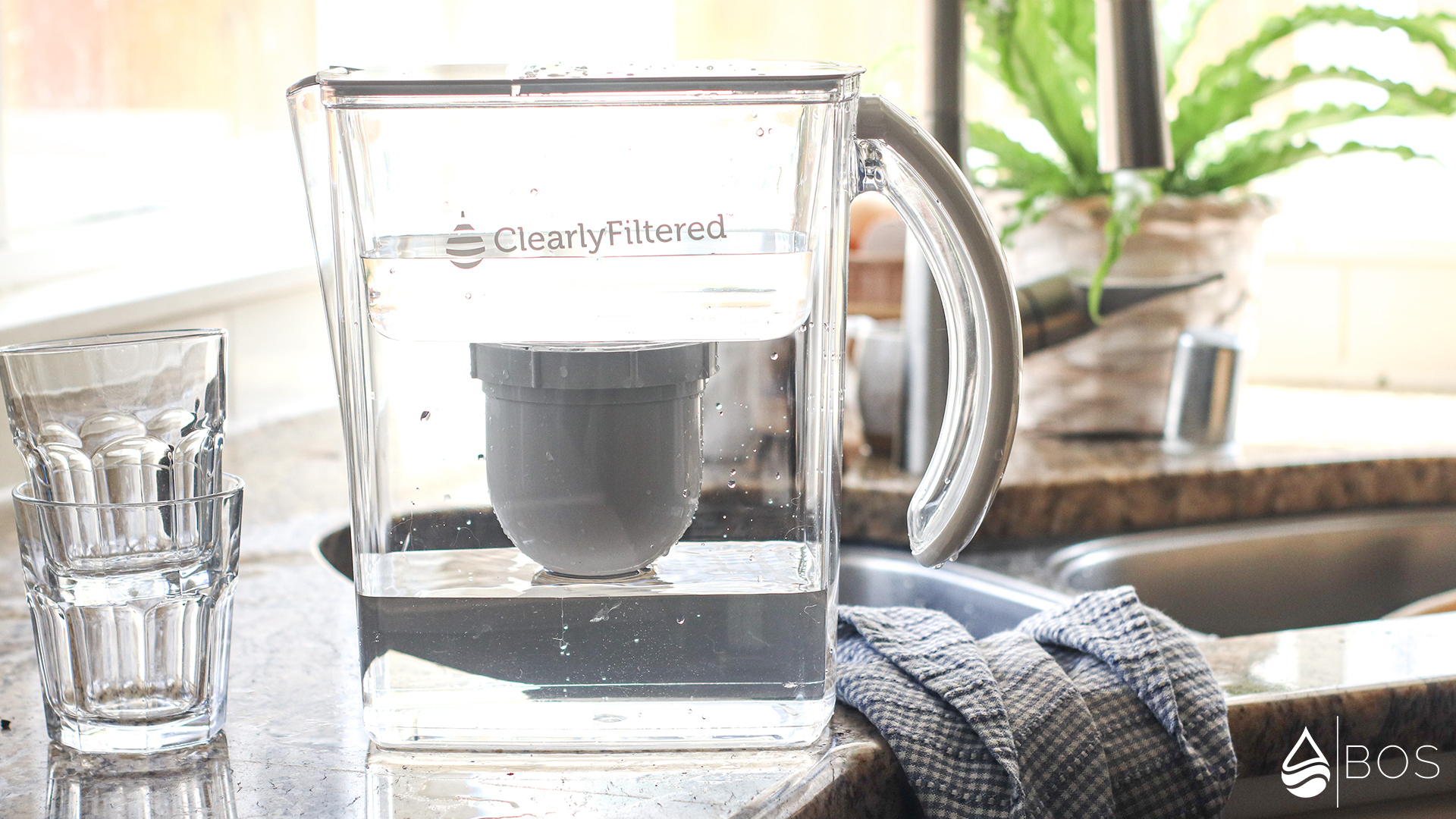This page contains affiliate links. If you buy a product or service through such a link, we earn a commission at no extra cost to you. Learn more.

Our Verdict (Best for)
The Clearly Filtered earns our top spot as the #1 all-around water filter pitcher (it’s also possibly highly effective targeting fluoride but our lab data might be flawed here). In our lab testing, it removed all contaminants to below detection levels with just a few exceptions. The filtered water also tasted and smelled perfectly clean. We were also impressed by the pitcher’s extensive third-party (NSF) testing, which covers 354 contaminants – although we would have liked more NSF certifications. On the downside, the Clearly Filtered isn’t cheap and filtration is pretty slow. Usability could also be improved: Overall filter priming, the lid that must be removed for refilling, and the pour flap.
The Clearly Filtered is a water filter pitcher. It’s designed for use as a drinking water filter and can purify both tap water and properly disinfected well water.
As usual, we’ve tested the pitcher with our own hands:
- Hands-on experience: We assembled, primed, used, and maintained it.
- Filtration effectiveness: We sent an unfiltered and a filtered tap water sample to a professional lab for analysis in order to determine real-life contaminant reduction capabilities. Plus, we checked for NSF certifications and other test data.
- More testing: We performed a taste & odor test as well as a filtration speed test.
- All other product aspects: We considered initial + long-term cost, product warranties, additional features, frequent customer complaints, etc.
Contents

Overall Rating: /5.00
Filtration: /5.00
Usability: /5.00
Costs: /5.00
| Type: | Water Filter Pitcher |
| Price (Jan 20, 2025, w/o Short-Term Sales): | $100 (Use Code BOS10 for 10% Off!) |
| Estimated Yearly Cost (Mar 19, 2024): | ~$150 (Save 10% With Filter Subscription) |
(Use Code BOS10 for 10% Off!)
Overall Rating: /5.00
What We Like Most
- Good filtration results in our lab testing especially for a water filter pitcher.
- Taste and odor of filtered water were flawless.
- NSF/ANSI certification against NSF standards 42 and 53 for 4 contaminants.
- Performed contaminant reduction testing for 354 contaminants (but not all against NSF standards).
- Straightforward to use and maintain, with a 100-gallon lifespan.
What We Don’t Like
- Very thoroughly tested against NSF standards, but few actual certifications.
- Initial setup issues with the filter priming disc popping off the priming bag.
- Slow filtration speed.
- Lid must be remove for refilling and flap doesn’t open easily when pouring.
- No filter life indicator.
- Expensive to purchase and maintain.
- Third-party customers complained about clogged filters and the lid falling off when pouring.
How the Clearly Filtered Water Pitcher Compares to…
10 Other Water Filter Pitchers
In this video, Mike explains why the Clearly Filtered became our #1 all-around water filter pitcher, plus why we think it’s possibly the best for reducing fluoride.
Please note: Our full guide on the best water filter pitchers is available here.
Video Chapters + Comparison Sheet
- Link to Comparison Sheet
- 00:00 – Intro
- 00:58 – Our 11 Pitchers
- 02:00 – How We Tested & Ranked
- 04:29 – Pitcher Assembly & Filter Priming
- 05:21 – Sampling Process
- 06:18 – Taste & Odor Test
- 06:58 – Speed Test
- 08:28 – Best Overall (Clearly Filtered)
- 12:27 – Best for Usability + Affordability (Waterdrop)
- 15:45 – Best for Bacteria & Cyst (LifeStraw)
- 18:30 – Best for Nitrate (ZeroWater)
- 23:00 – Best for Fluoride
- 23:39 – Summary
Full Analysis of the Clearly Filtered Water Pitcher
Please note: We repeated our lab analysis due to filter priming issues in our first round of testing. In our second round of testing we took 2 filtered water samples using 2 fresh filter cartridges.
Filtration: /5.00
1. Lab Results: /5.00
Remember that our before vs after lab comparison is not an exact science. It’s informational and subject to variability, inaccuracies, and interferences caused by natural fluctuations in water quality, accidental contamination, human error, instrumentation issues, and more. Furthermore, our lab-testing is limited to those contaminants present in our water supplies and at their respective concentrations. As such, it can only give us a general idea for how effective a certain water treatment product might be.
Lab Results Chart
| Potentially Harmful | Aesthetic Issues | Feed Water Level | Filtered Water Level | Reduction Rate | |
| Water Disinfectants | |||||
| Chlorine (mg/L) | ✖ | ✖ | 1st Round: 0.2 2nd Round: 0.15 |
1st Round: 0 2nd Round: 0 | 0 |
100% (Avg of 3) |
| Disinfection Byproducts | |||||
| Bromodichloromethane (µg/l) | ✖ | 0.58 | 0 | 100% | |
| Bromoform (µg/l) | ✖ | 0.75 | 0 | 100% | |
| Dibromochloromethane (µg/l) | ✖ | 0.94 | 0 | 100% | |
| Metals | |||||
| Copper (mg/L) | ✖ | ✖ | 1st Round: 0.01 2nd Round: 0.02 |
1st Round: 0 2nd Round: 0 | 0 |
100% (Avg of 3) |
| Barium (mg/L) | ✖ | 1st Round: 0.01 2nd Round: 0.01 |
1st Round: 0 2nd Round: 0 | 0 |
100% (Avg of 3) | |
| Boron (mg/L) | ✖ | 1st Round: 0.04 2nd Round: 0.03 |
1st Round: 0.01 2nd Round: 0.03 | 0.04 |
14% (Avg of 3) | |
| Lithium (mg/L) | ✖ | 1st Round: 0.01 2nd Round: 0.02 |
1st Round: 0 2nd Round: 0 | 0 |
100% (Avg of 3) | |
| Strontium (mg/L) | ✖ | 1st Round: 0.18 2nd Round: 0.2 |
1st Round: 0 2nd Round: 0 | 0 |
100% (Avg of 3) | |
| Salts | |||||
| Nitrate (N) (mg/L) | ✖ | 1st Round: 1.65 2nd Round: 1.42 |
1st Round: <0.5 2nd Round: 1.89 | 1.69 |
6% (Avg of 3) | |
| Fluoride (mg/L) (Flawed?) | ✖ | 1st Round: 0.46 2nd Round: 0.57 |
1st Round: 1.71* 2nd Round: 1.07* | 1.67* |
184% Increase* (Avg of 3) | |
| Other | |||||
| Uranium (µg/L) | ✖ | 1st Round: 7 2nd Round: 6 |
1st Round: 0 2nd Round: 0 | 0 |
100% (Avg of 3) | |
| Aesthetic Parameters | |||||
| Hardness (mg/L) | ✖ | 1st Round: 111.9 2nd Round: 113.6 |
1st Round: 4.6 2nd Round: 7.9 | 2.6 |
95% (Avg of 3) | |
| Impurities NOT Detected in Unfiltered Tap Water Sample | |||||
| Silver (mg/L) | ✖ | 0 | 0.03 | 0.02 | 0.05 | ||
| Titanium (mg/L) | ? | ? | 0 | 0.09 | 0.03 | 0.09 | |
| *Due to known interferences of the applied testing method, we assume fluoride levels must be taken with a grain of salt. | |||||
| Explanation: | |||||
| Full Removal | |||||
| Considerable Reduction | |||||
| Concentration More Than Double of Unfiltered Water Sample | |||||
| Potential Leaching Reached or Exceeded the Strictest Public Health Guideline We Could Find | |||||
*100% means reduction to below the minimum detection level. To learn more about our testing procedures check our editorial guidelines.
Link to Filtered Water Report for 1st Round of Testing (Priming Issue)
Link to Unfiltered Water Report for 1st Round of Testing (Priming Issue)
Link to Filtered Water Report #1 for 2nd Round of Testing
Link to Filtered Water Report #2 for 2nd Round of Testing
Link to Unfiltered Water Report for 2nd Round of Testing
Usability: /5.00
Costs: /5.00
Please note: This page is still a work in progress. Additional content and details will be added shortly – stay tuned!
Further Reading


